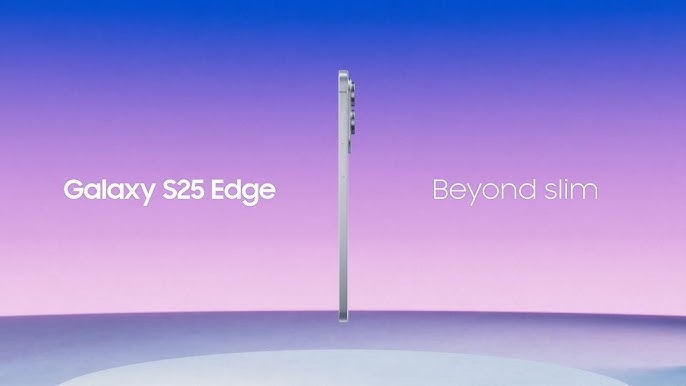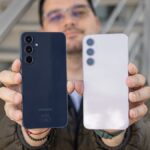The Galaxy S25 Edge is Samsung’s most daring hardware play in recent year, not because it’s folding, flipping, or sliding, but because it’s unapologetically thin.
At just 5.8mm, it carves out a unique space in the flagship lineup as a device engineered for minimalism without (mostly) sacrificing the user experience they have come to expect.
When Samsung first teased the Edge, the focus was all on its razor-thin design. And the immediate question was: Do we even want thinner phones anymore?
We’re already in an era of sleek slabs where most devices are comfortably light and slim. Yet, Samsung seems to think there’s still room—literally and figuratively—to go thinner. And after spending time with the Edge, it’s clear there is something appealing here.
Holding the S25 Edge is a bit surreal. It’s light—lighter than any phone this size should be. At 163g, it weighs the same as the compact base S25, despite housing the same 6.7-inch 120Hz AMOLED display as the S25 Plus.
That combination of lightness and size gives the Edge a strange, almost futuristic tactility. You don’t expect a phone this large to feel so airy, and once you handle it, it becomes oddly convincing.
Design-wise, the Edge is sleek and modern, with clean flat sides and a minimalist camera bump that’s more of a design statement than an eyesore.
The titanium frame adds durability to the slender body, and it comes in three subtle but premium finishes: jet black, silver, and icy blue tone. It’s not trying too hard, and yet it will absolutely turn heads.
What’s Inside (And What’s Missing)
The Galaxy S25 Edge isn’t just thin for thinness’s sake. It packs a lot of flagship DNA:
- Processor: Snapdragon 8 Gen 3 “Elite” with a custom NPU
- Display: 6.7-inch 1440p AMOLED, 120Hz
- Memory: 12GB RAM
- Storage: 256GB or 512GB
- Cameras: 200MP f/1.7 main sensor at 8K30 rear video (same as the S25 Ultra), 12MP f/2.2 ultrawide, 4K-60 front camera
- Build: Titanium frame, Gorilla Glass Ceramic 2 on the front, Victus 2 on the back
It includes high-end features like 15W wireless charging, reverse wireless charging, and an in-display fingerprint sensor. Remarkably, it even maintains a vapor chamber cooling system—something often sacrificed in thinner phones.
However, some omissions were inevitable. There’s no telephoto lens, which means no optical zoom. And the battery takes a noticeable hit, dropping to a 3,900mAh cell, and yes, no anti-reflective screen here either.
For a phone this thin, that’s not shocking—but it is concerning when compared to the 4,900mAh in the S25 Plus, which has the same screen size.
More puzzling is Samsung’s decision to stick with traditional lithium-ion batteries here, rather than the newer silicon-carbon anode tech that’s already used in phones from OnePlus, Xiaomi, and Vivo.
That newer battery tech offers up to 20% more energy density—perfect for a slim device like this. Its absence feels like a missed opportunity, especially at a starting price of $1,099.
Performance and Experience
In daily use, the S25 Edge holds its own. It runs Samsung’s familiar One UI with all the expected AI features and system refinements.
Despite its thin chassis, performance holds steady, and thermals are surprisingly well-managed thanks to the internal vapor chamber.

Audio quality is solid, though not mind-blowing, considering the smaller speaker chamber. The fingerprint sensor remains quick and reliable. Even the physical SIM tray survives the slimming process—a welcome touch in an increasingly eSIM-centric world.
But there’s no denying the Edge is a phone of compromises. The camera bump protrudes more noticeably due to space limitations. The smaller battery might struggle for power users, especially with the large, high-resolution screen. And the lack of a telephoto lens means photography versatility takes a step back.
Who Is This For?
The Galaxy S25 Edge isn’t meant to be the mainstream flagship. It’s designed for a niche—a user who values aesthetics, design engineering, and portability over maximum specs. Think of it as the “Ultra Light” version of the Ultra—same DNA, just stripped down for elegance.
If you don’t mind losing some battery life and zoom range in favor of a sleeker, more futuristic profile, this might be the phone for you. If you crave all-day endurance and pro-level cameras, look toward the S25 Ultra instead.
But perhaps most importantly, the S25 Edge is a technological showcase. It proves that Samsung can—and will—build ultra-thin hardware without completely compromising the experience. That bodes well for the future.
As manufacturing catches up and new battery tech becomes more accessible, this kind of engineering could trickle into more devices over time.
Most people weren’t begging for thinner phones. But after holding the S25 Edge, you might start to see the appeal. It’s not just a spec sheet warrior—it’s a vision of where smartphone design could go next. And even if it’s not for everyone, it pushes how thin a phone can be.














